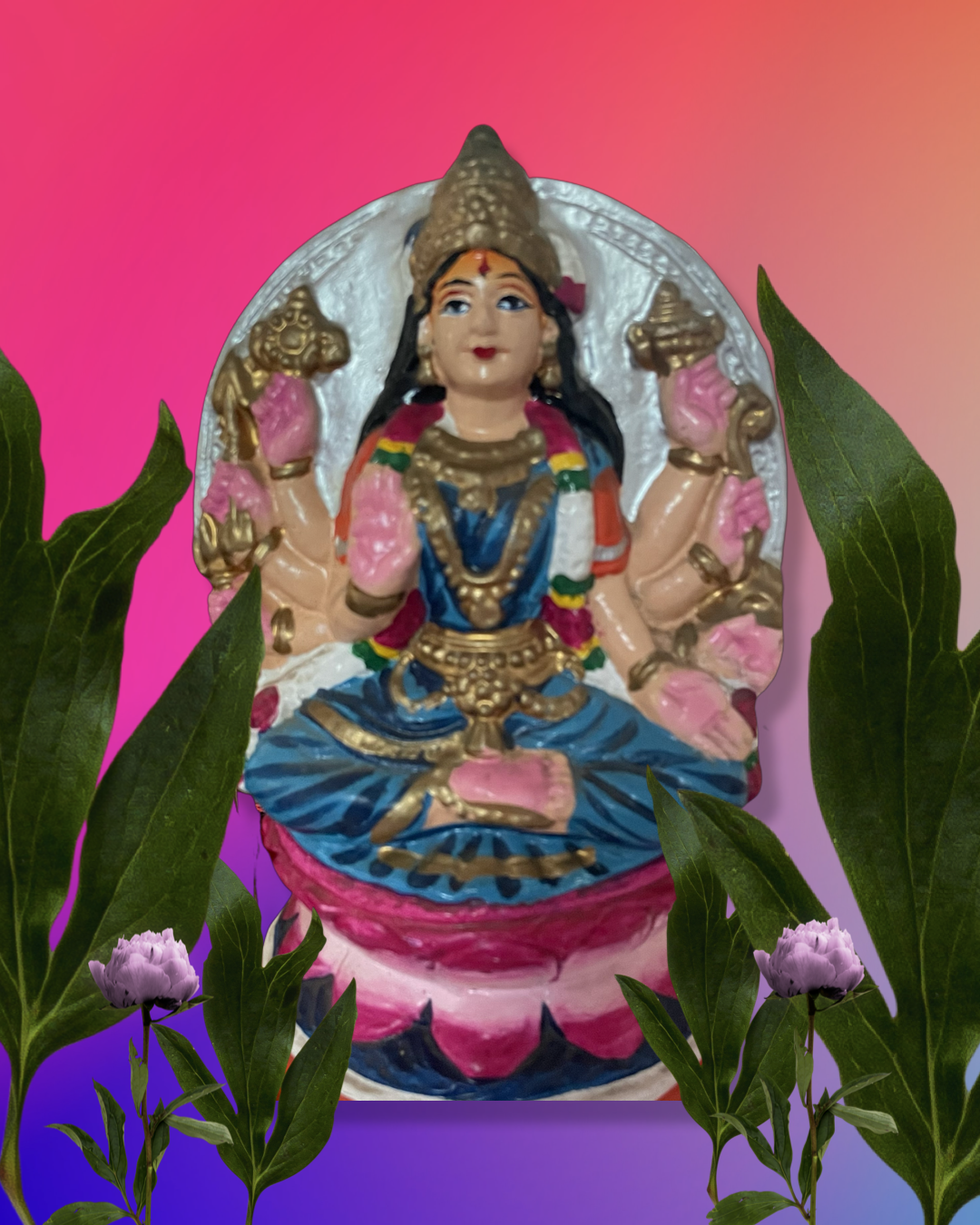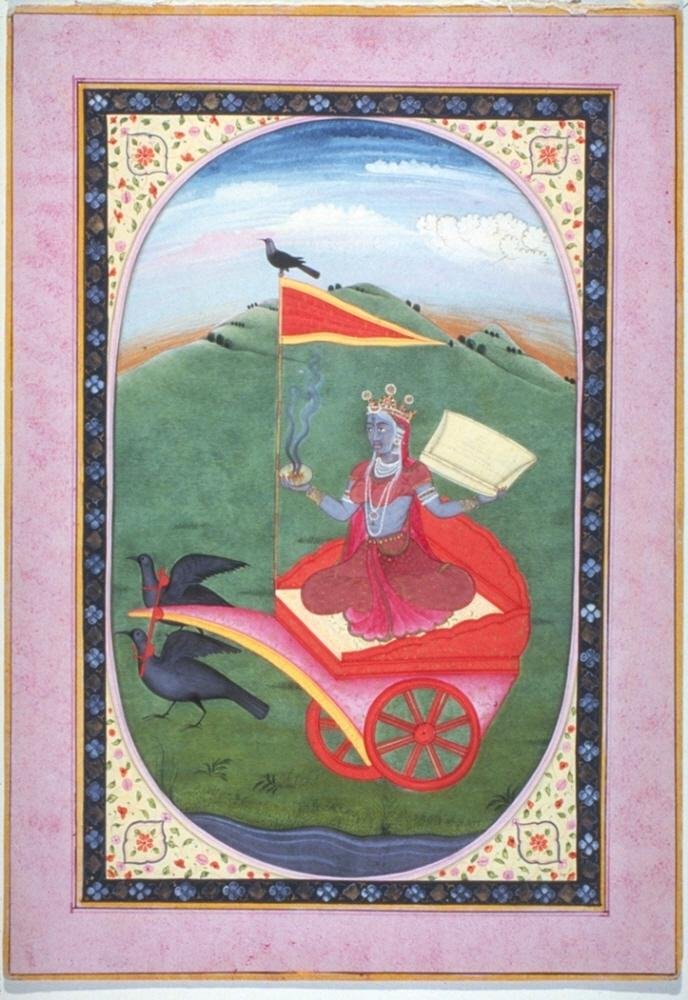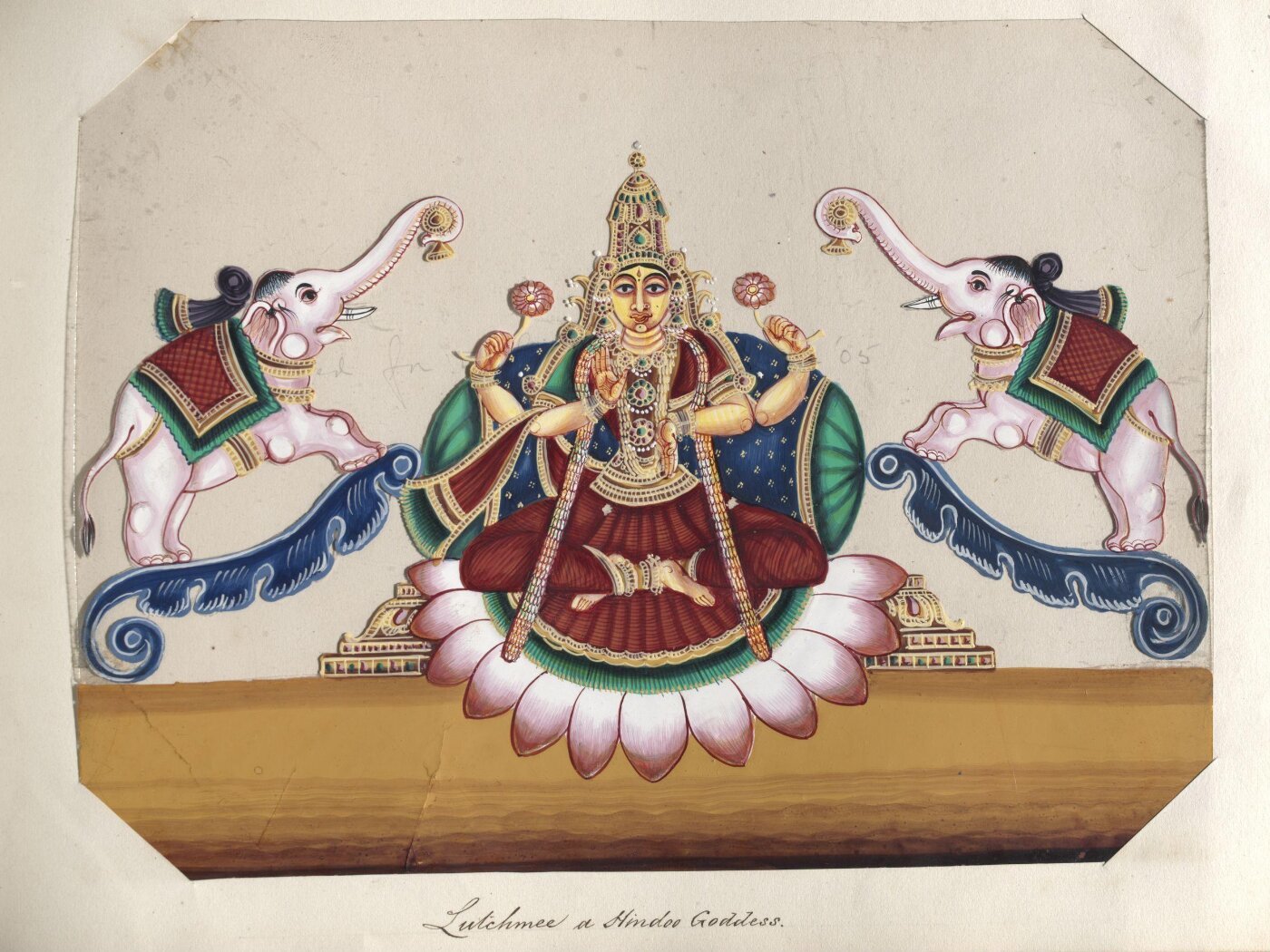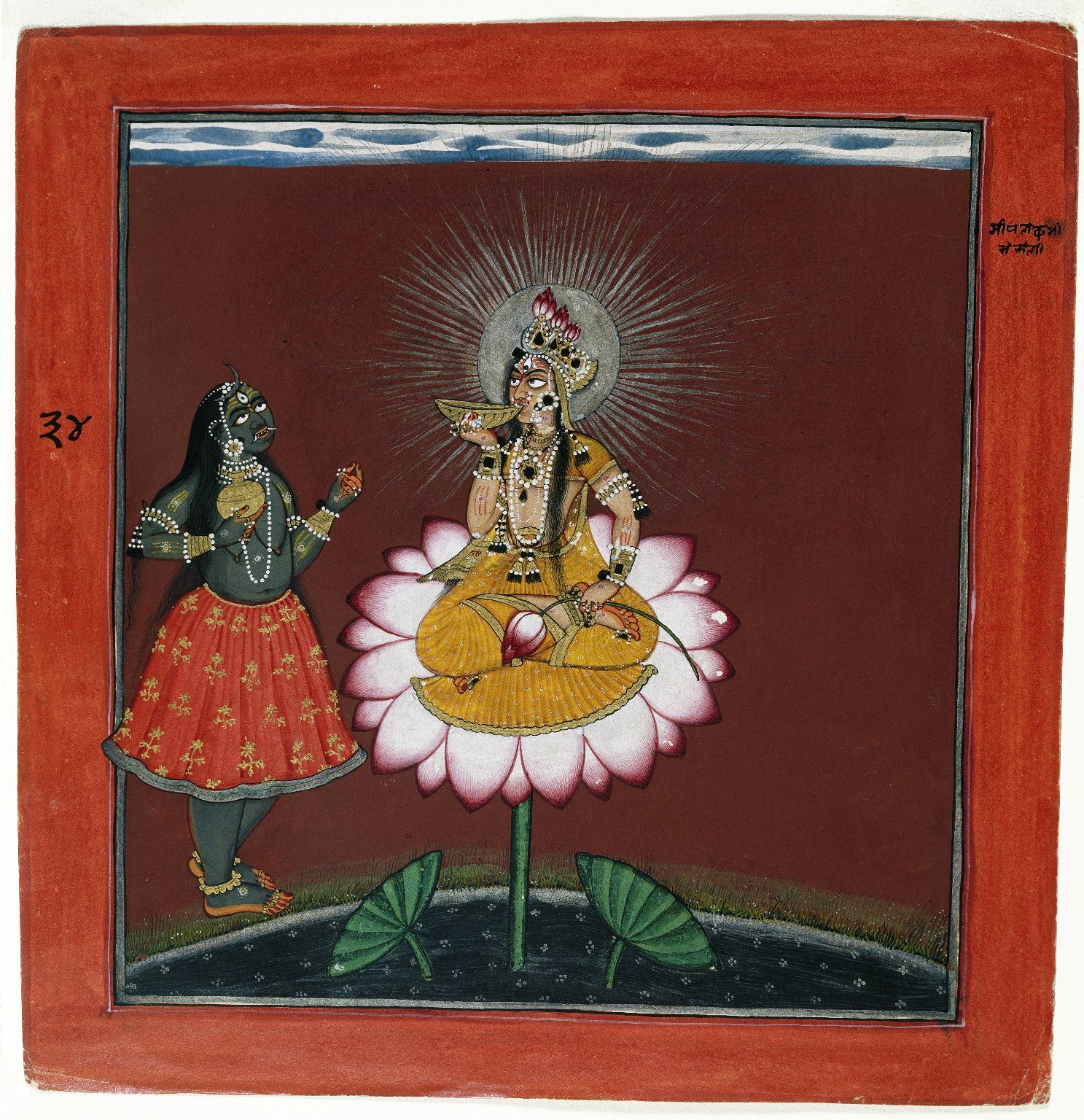Lakshmi, Hindu Goddess of Good Fortune
In the mystical tapestry of Hindu mythology, two sisters weave their contrasting threads—the radiant and the withered, the abundant and the barren. Their names resonate through time: Lakshmi and Alakshmi.
Lakshmi: The Golden Goddess of Good Fortune
Lakshmi (or Laxmi) is the Hindu goddess of wealth, prosperity and good fortune. Associated with beauty, grace, and charm, she is a consort of Lord Vishnu, one of the principal deities in Hinduism.
Lakshmi graces our hearts like a sun-kissed morning. She is the embodiment of prosperity, her allure drawing souls like moths to a celestial flame. With eyes like lotus petals and a smile that births a thousand blessings, she dances upon golden lotus blooms. Her presence brings abundance; her touch turns poverty into opulence. Wherever Lakshmi treads, wealth follows, and her devotees thrive.
Lakshmi is commonly depicted as a beautiful woman with four arms, either sitting on or holding a lotus flower. Sometimes she also holds a cornucopia and is depicted alongside elephants — usually white elephants — in Hindu art and iconography. The elephants are lustrating the goddess — i.e. purifying her with ceremonial washing.
The elephant itself is also a symbol of good luck and prosperity, and it is said that the presence of elephants in a home or temple brings blessings of wealth and good fortune.
But we live in a world of balance, dear readers, where there is a yin for every yang.
Where there is a goddess of good fortune, there must also be a goddess of misfortune. Enter Lakshmi’s older sister — Alaskshmi.
Alakshmi: The Barren Goddess of Poverty
Alakshmi is the goddess of poverty, misery and misfortune. If Laskshmi is the epitome of beauty and grace, Alakshmi is her opposite — a haggard, unwashed crone who is associated with negative traits like selfishness and arrogance.
Her domain is the neglected corners—the dirt, filth, and crime. Alakshmi rides a donkey, unkempt and naked, her eyes red with bitterness. Poverty clings to her like a tattered cloak, and wherever she steps, hopelessness sprouts. She is the antithesis of Lakshmi, the dark side of fortune’s wheel.
Why would anyone worship a Goddess of Misfortune?
Well, Alakshmi serves as a reminder that fortune’s glow casts darkness too. She is the echo of decay, the price paid for abundance.
So it’s more about appeasing Alakshmi so that she doesn’t bring misfortune into your life. One does this by worshipping Lakshmi, living a virtuous life and keeping the house clean. However, in worshipping Lakshmi, one’s intentions must be sincere. If offerings to her are made from a place of selfishness or greed, big sister Alakshmi will pay you a visit. When Lakshmi is depicted with an owl, it serves as a reminder not be foolish or greedy with one’s wealth. The owl is also a fierce bird of prey that is able to fend off evil spirits and negative energies, thereby safeguarding Lakshmi's divine energy and power.
A special talisman is used as an offering to Alakshmi. The talisman, known as a nimbu mirchi totka, consists of seven chilis (mirchi) and a lemon (nimbu). Alakshmi is said to prefer sour, pungent and spicy flavors so the combination of the chili peppers and lemons is impossible for her to resist. Drawn to the citrus-y, peppery fragrance, Alakshmi feasts on the nimbu mirchi and stays outside the shop or house, keeping misfortune at bay. Alakshmi is often depicted with crows. Having a crow enter one’s home is considered an inauspicious sign, and it's believed that Alakshmi is entering the house.
As you might expect, Lakshmi is much more popular than her sister, and for this reason, images depicting Lakshmi are comparatively rare.
Terracotta Statue of Lakshmi seated on a lotus flower, House of Good Fortune Collection.
LOTUS GODDESS, LAKSHMI, Nepal, 17th century, wood with pigments and gilt repoussé, from the collection of the Rubin Museum of Art.
Lakshmi is a goddess of wealth. Buddhists may identify her as Tara. Unequivocally, however, she is a lotus goddess. Her throne, pedestal, attributes, and tiara are all decorated with lotuses. A lotus naturally grows out of mud immediately after the monsoon rain and blossoms in autumn when rice is ready for harvesting. Thus, a lotus goddess is the goddess of wealth, of the harvest.
Painting; gouache on mica, Lakshmi being lustrated by elephants, Trichinopoly, ca.1850, from the collection of the Victoria & Albert Museum.
Shri Shri Lakshmi Narayana, Published by Kansaripara Art Studio, c. 1900, from the Museum of Fine Arts Boston.
Goddess Kamalamika, designed and published by The Hindu Art Studio, ca. 1880–85, from the collection of The Metropolitan Museum of Art.
The beautiful and benign goddess Kamalamika, the “[red] lotus lady,” is a tantric form of Lakshmi, Hinduism’s embodiment of all that is auspicious and abundant. In her esoteric aspect as Kamalamika, she is enthroned on a red-lotus pedestal that rises from the silvered waters of a mountain lake, evoking her divine nature. Another flower bud serves as her footrest. In her four arms she displays lotus buds and a bloom and extends auspicious gestures to her devotees. In the heavenly skies above four white elephants hold golden pitchers (lota) in their extended trunks, allowing the waters to cascade upon the head of the goddess, empowering her with the life affirming waters that ensure abundance in all things.
Siddha Lakshmi with Kali, Opaque watercolor, gold, silver, and beetle wing cases on paper, India, ca. 1660-1670, from the collection of the Brooklyn Museum.
Inscribed at top: Siddha Lakshmi with Kali. On reverse: One should (let one) meditate thus in the lotus of his heart on Siddha Lakshmi, goddess of remembrance, Bhadrakali (all epithets of Siddha Lakshmi) who is young, with a face resembling the rising moon and crown bedecked with the crescent moon. Whose pricelessly graceful form is clad in a yellow dress, seated on an eightfold (cosmic) lotus, accompanied by Kali, drinking draughts of liquor. Translated by Sonali Mitra. Inscribed on top right: Siddha Lakshmi with Kali.
The Eight Forms of Lakshmi
In Hinduism, Lakshmi is believed to have eight forms or manifestations, known as the Ashtalakshmi. Each form represents a different aspect of wealth, prosperity, and well-being. The eight forms of Lakshmi are:
Adi Lakshmi - The first form of Lakshmi, Adi Lakshmi, represents the primal energy of the universe and is associated with spiritual wealth.
Dhana Lakshmi - This form of Lakshmi is associated with material wealth and prosperity, and is often depicted holding a pot of gold or other treasures.
Dhanya Lakshmi - Dhanya Lakshmi is the goddess of agricultural wealth and is associated with crops, food, and nourishment.
Gaja Lakshmi - This form of Lakshmi is associated with power, strength, and courage. Gaja Lakshmi is often depicted riding on an elephant and holding lotus flowers.
Santana Lakshmi - Santana Lakshmi is the goddess of progeny and is associated with fertility, motherhood, and children.
Veera Lakshmi - This form of Lakshmi represents valor, bravery, and courage. Veera Lakshmi is often depicted holding a sword and shield.
Vidya Lakshmi - Vidya Lakshmi is the goddess of knowledge and wisdom, and is associated with learning, education, and the arts.
Vijaya Lakshmi - This form of Lakshmi is associated with victory, success, and accomplishment. Vijaya Lakshmi is often depicted holding a lotus flower and a sword, symbolizing success and determination.
Each of these eight forms of Lakshmi is revered and worshipped in Hinduism for the blessings they bring in various aspects of life.








